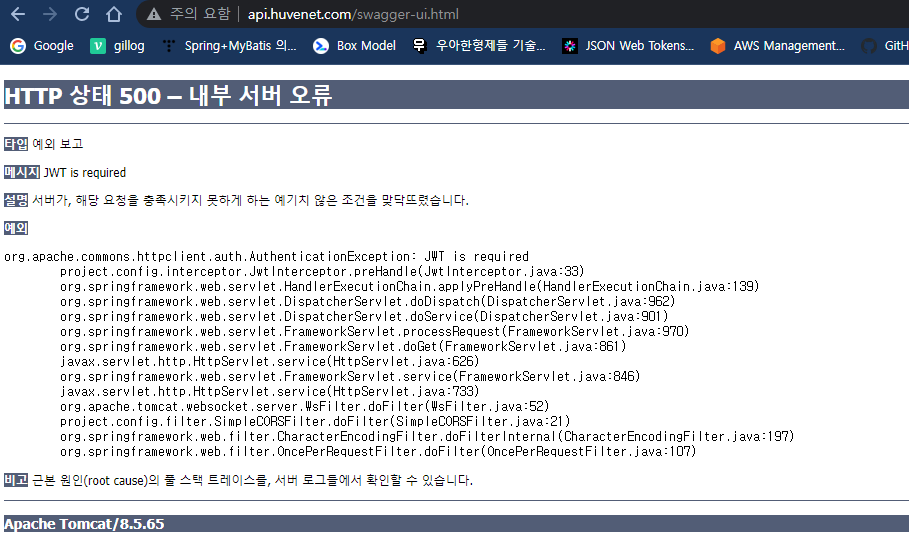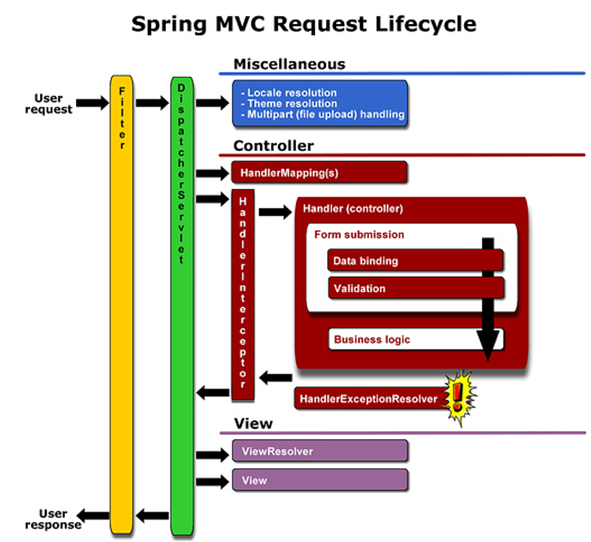[Spring] DispatcherServlet의 예외처리 전략(HandlerExceptionResolver)
Spring
#import
public class JwtInterceptor extends HandlerInterceptorAdapter {
@SuppressWarnings("unused")
private static final Logger LOG = Logger.getLogger(JwtInterceptor.class);
@Autowired
private TokenService tokenService;
private static final String SWAGGER_URI = "swagger-ui.html";
@Override
public boolean preHandle(HttpServletRequest request, HttpServletResponse response, Object handler)
throws AuthenticationException {
if (request.getMethod().equals("OPTIONS")) {
return true;
}
String jwt = request.getHeader("Authorization");
if (jwt == null) {
LOG.error("[JwtInterceptor] JWT is null");
throw new AuthenticationException("JWT is required");
}
try {
ResultJWT resultJWT = tokenService.getResultJWT(jwt);
if (request.getRequestURI().contains(SWAGGER_URI)
&& ((resultJWT.getRole() == null) || JWTRoles.USER.getRole().equals(resultJWT.getRole()))) {
LOG.error("[JwtInterceptor] JWT Role is not Allowed");
throw new AuthenticationException("JWT Role is not Allowed");
}
} catch (JwtException e) {
LOG.error("[JwtInterceptor] JwtException Throw");
throw e;
}
return true;
}
}현재 개발하고 있는 프로젝트단에서 JWT를 활용한 인증이 필요한 Handler를
공통적으로 인증 과정을 수행하는 HandlerInterceptorAdapter를 상속받는 JwtInterceptor를 위와 같이 사용하고 있었다.
위 인증 과정 중 인증 실패시 아래 처럼 Exception을 throw 하는 부분이 있는데,
throw new AuthenticationException("JWT is required");해당 프로젝트에서 @ControllerAdvice를 통해서 공통으로 Exception을 Handling 하고 있던 상황이라,
정상적으로 Exception Handling이 수행되고 있다고 생각하고 있었다.
@RestControllerAdvice
public class ExceptionController {
@SuppressWarnings("unused")
private static final Logger LOG = Logger.getLogger(ExceptionController.class);
private static final String DEFALUT_MESSAGE_AUTHENTICATION = "Authentication is not valid";
@Autowired
private ExceptionService exceptionService;
@ExceptionHandler(AuthenticationException.class)
protected ResponseEntity<ErrorResponse> handleAuthenticationException(AuthenticationException e,
HttpServletRequest request) {
exceptionService.errorLog(e, request);
String message = e.getMessage() == null ? DEFALUT_MESSAGE_AUTHENTICATION : e.getMessage();
return new ResponseEntity<>(new ErrorResponse(HttpStatus.UNAUTHORIZED.value(), message, request.getSession().getId()),
HttpStatus.UNAUTHORIZED);
}
}
하지만 위와 같이 해당 Interceptor 단에서 throw 하던 Exception들은,
@ControllerAdvice단에서 Handling 하지 못하고 있었고,
결국에는 preHandle() 단에서 throw가 아닌 return false로 handler로 전달되지 않는 Logic으로 변경하였다.
오늘은 이를 해결하는 동안 파악한 Exception Handling 관련 내용들을 gillog 한다.
HandlerInterceptor
먼저 아래 그림을 통해 Spring에서 MVC Request의 Lifecycle 과정을 확인해보면
🙈[Spring] Interceptor (1) - 개념 및 예제🐵[victorydntmd.tistory.com]
HandlerInterceptor단은 Handler(Controller) 수행 전에,
DispatcherServlet에게 Request를 위임받아 처리하는 객체이다.
@ControllerAdvice는 Handler(Controller)단에서 발생하는 Exception을,
@ExceptionHandler Annotation으로 처리하는 Logic이라 Exception Handling이 불가능한 상황이었다.
원래 의도했던 Logic이 해당 Handler로 접근하기 전 올바른 권한을 확인 하고,
정상 권한이 없는 상황에서 접근 제한 용도로 작성했던 throw AuthenticationException() Logic이라,
단순히 preHandle()에서 return false를 통해 해당 Handler로 접근을 제한하는 방법으로 변경했다.
아래 내용 부터는 Spring에서 Exception Handling이 처리되는 과정을,
이번 기회를 통해 알게된 사항들을 작성한 부분이다.
HandlerInterceptor단 Exception Handling
Handler(Controller)에서 발생한 Exception을 Handling 하기 위해서는,
HandlerExceptionResolver의 Exception Handling 전략을 사용해야 한다.
HandlerExceptionResolver 활용
HandlerExceptionResolver는 Controller의 작업 중 발생한 Exception을 처리하는 결정 전략 객체이다.
Handler(Controller)나 그 뒤 계층에서 throw된 Exception은,
DispatcherServlet이 일단 전달 받은 뒤,
다시 Servlet 밖의 Servlet Container가 처리하게 되는데,
HandlerExcetpionResolver가 등록되어 있지 않다면,
HTTP Status 500 내부 서버 오류 와 같은 메시지가 브라우저 단에 노출된다.
하지만 HandlerExceptionResolver가 등록되어 있는 경우,
DispatcherServlet은 먼저 HandlerExceptionResolver가 해당 Exception을 Handling 할 수 있는지 확인하고,
Exception Handling이 가능한 경우 해당 HandlerExceptionResolver에게 Exception Handling을 위임한다.
HandlerExceptionResolver를 구현하기 위해서는 아래 Interface를 implements하면 되는데,
public interface HandlerExceptionResolver {
/**
* Try to resolve the given exception that got thrown during handler execution,
* returning a {@link ModelAndView} that represents a specific error page if appropriate.
* <p>The returned {@code ModelAndView} may be {@linkplain ModelAndView#isEmpty() empty}
* to indicate that the exception has been resolved successfully but that no view
* should be rendered, for instance by setting a status code.
* @param request current HTTP request
* @param response current HTTP response
* @param handler the executed handler, or {@code null} if none chosen at the
* time of the exception (for example, if multipart resolution failed)
* @param ex the exception that got thrown during handler execution
* @return a corresponding {@code ModelAndView} to forward to,
* or {@code null} for default processing in the resolution chain
*/
ModelAndView resolveException(
HttpServletRequest request, HttpServletResponse response, Object handler, Exception ex);
}구현해야 하는 resolveException() method는 return type이 ModelAndView로,
예외 노출에 사용될 View와 그 안에 포함될 내용을 담은 Model 객체를 return 하도록 작성해주면 된다.
@ExceptionHandler를 통해서 Exception을 Handling 하는 전략도,
AnnotationMethodHandlerExcetpionResolver 방식으로,
네 가지 HandlerExceptionResolver 구현 전략 중 한 가지 이다.
ResponseStatusExceptionResolver : Exception을 특정 HTTP 응답 상태 코드로 전환 해주는 전략
DefaultHandlerExceptionResolver : 404(NoSuchRequestHandlingMethodException), 400(TypeMissmatchException) 등 기본 Spring에서 마지막으로 Exception을 Handling 해주는 표준 예외처리 전략
SimpleMappingExceptionResolver : web.xml의 <error-page>등으로 선언하는 예외 처리 view 지정 전략
그렇다면 HandlerInterceptor단에서 Exception을 어떻게 처리할 수 있을까
Request 객체 forward
그나마 접근한 방법은 HandlerInterceptor단에서 preHandle() method에서,
해당 Request가 가고자하는 handler가 아닌,
Exception 처리를 관장하는 Handler로 Request를 Forward 시키는 방법이다.
아래 코드를 살펴보자.
@Override
public boolean preHandle(HttpServletRequest request, HttpServletResponse response, Object handler)
throws AuthenticationException {
if (request.getMethod().equals("OPTIONS")) {
return true;
}
String jwt = request.getHeader("Authorization");
if (jwt == null) {
LOG.error("[JwtInterceptor] JWT is null");
request.setAttribute("message", "JWT is required");
request.setAttribute("exception", "AuthenticationException");
request.getRequestDispatcher("/error").forward(request, response);
}
return true;
}
위 코드와 같이 HandlerInterceptor단에서 예외상황 발생시,
/error와 같은 Handler(Controller)단으로 request를 forward 시킨 후,
@GetMapping("/error")
@ResponseBody
public void handlerError(HttpServletRequest request) throws Exception {
String message = (String) request.getAttribute("message");
String exception = (String) request.getAttribute("exception");
if(exception.equals("AuthenticationException")){
throw new AuthenticationException(message);
} else {
throw new Exception(message);
}
}Handler(Controller)를 등록하여 @ControllerAdvice단에서 Exception을 Handling 할 수 있도록 처리하는 방법이다.
위 방법으로 처리하는것 보다,
예외 상황 발생 시 Interceptor 단에서 그냥 Handler로의 접근을 return false로 끊어버리는게 더 올바른 방법이라 생각하여,
해당 방법은 실제로 사용하지는 않았다.
만약 비슷한 고민을 가지고 이 글을 읽고 계신 분이 계시다면,
더 현명한 처리 전략에 대해 고민 하실 수 있기를 바라며 gillog를 마친다. 🙋♂️

